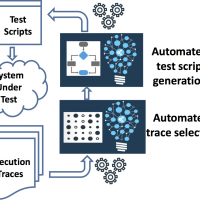Project concept, positioning and objectives
“As we met with hundreds of software teams, we latched on to this idea that developing — the process of writing new code and integrating it with your code bases — is very fast now, but there’s a bottleneck in QA. Every time you make a change to your product, you have to test this change or build test automation.” – Izzy Azeri / mabl – February 2018
Testing Web-based Information Systems has become a major bottleneck for many large companies and SMEs. Besides the ever-growing complexity of such systems, their indispensable assurance quality requirements have led to dramatically increase the verification and validation costs. A fine-grained analysis of existing testing procedures reveals however that not all artefacts are exploited to tame this cost increase. In particular, test and operational execution traces are usually ignored by validation engineers. This does not come as a big surprise as these traces are almost impossible to classify and analyze by hand. Besides, test models used to generate test cases in model-based testing approaches are difficult to maintain and evolve. As a result, they are often abandoned and replaced by test scripts developed from scratch, which increases the validation costs.
The objective of the PHILAE project is to combat the testing bottleneck by performing trace analysis and triage using machine learning techniques, combining this analysis with model inference and automated test generation. By demonstrating this key-enabling approach on three industrial case studies, with an industry-strength tool-chain developed in the project, we plan to change the state-of-practice in terms of automated testing of web-based information systems by carefully moving from Model-Based Testing to Cognitive Test Automation.

